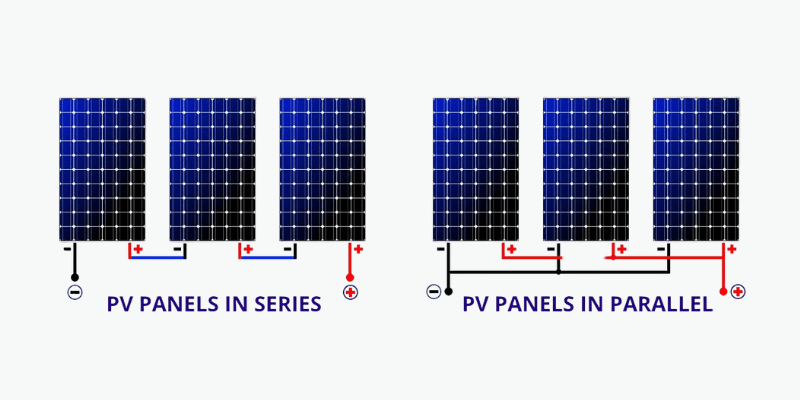Lors du câblage de plusieurs panneaux solaires, vous pouvez choisir entre Série ou configurations parallèles en fonction de votre application. Explorons les différences et les utilisations idéales pour chaque méthode.
Quelle est la différence? Panneaux solaires: série ou parallèle
Le câblage de vos panneaux solaires affecte les performances du système et la compatibilité de l'onduleur.
Lorsque vous câblez plusieurs panneaux en série, il augmente la tension tout en gardant le courant le même, en aidant à respecter la tension de fonctionnement minimale de l'onduleur.
En revanche, le câblage parallèle pour les panneaux solaires augmente le courant sans modifier la tension, permettant la production d'énergie dans les limites de l'onduleur.
Examinons comment câbler les panneaux dans les deux configurations.
Câblage du panneau solaire en série
Tension et ampères en série
La connexion du terminal positif d'un panneau à la borne négative d'un autre crée une connexion en série. Cette configuration résume toutes les tensions de panneau, mais le courant total reste égal à celui d'un seul panneau.
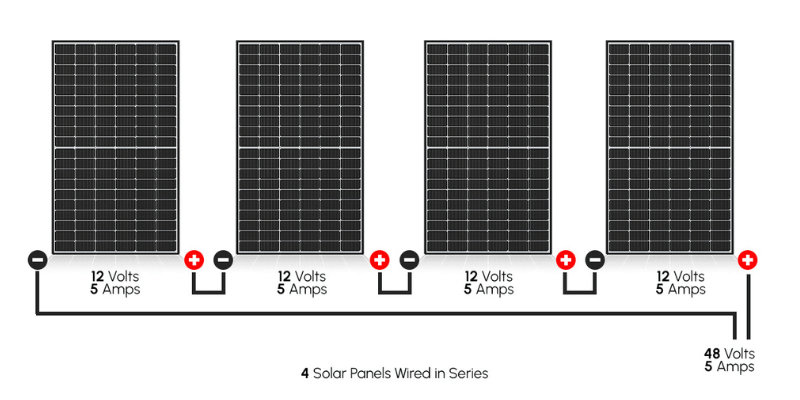
Le graphique ci-dessus montre quatre panneaux de 12 volts et 5 ampères câblés en série. La tension de sortie est de 48 volts (12V * 4 = 48V), mais le courant de sortie est toujours de 5 ampères.
Ce que c'est mieux pour
Les panneaux solaires en série fonctionnent les mieux dans des conditions non ombrées. Si un panneau est ombré, il réduit la sortie de sortie du système entier.
Les panneaux solaires en série sont idéaux pour les systèmes à faible ampleur car une tension plus élevée entraîne une ampérage plus faible, permettant des fils plus petits et moins chers.
Lorsque vous câblez vos panneaux en série, vous devez utiliser un Contrôleur de charge MPPT. Les contrôleurs MPPT ajustent la tension et le courant des panneaux solaires pour correspondre à la tension de la banque de batterie sans perdre de l'énergie. Si vous utilisez un contrôleur PWM, la batterie réduira la tension totale du tableau des panneaux, entraînant une perte de puissance importante.
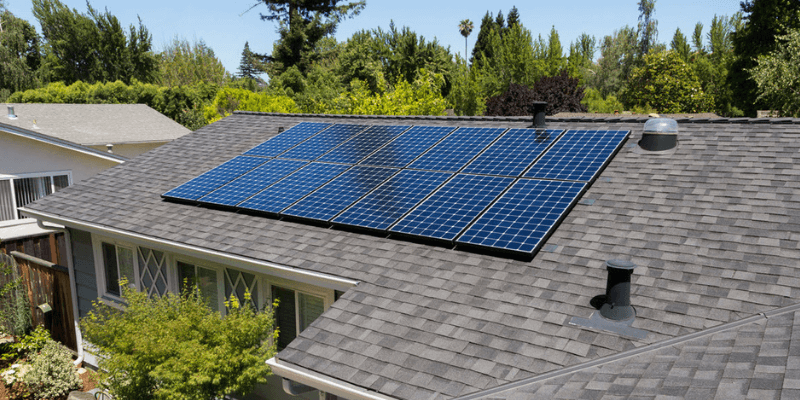
Câblage en panneau solaire parallèle
Tension et amplis en parallèle
Pour câbler les panneaux solaires en parallèle, connectez toutes les bornes positives ensemble, tout comme les bornes négatives. Le courant résultant égalera la somme de toutes les ampérages du panneau, tandis que la tension totale correspondra à la tension de sortie d'un panneau.
Lorsque plusieurs panneaux sont câblés en parallèle, il forme un circuit de sortie PV.
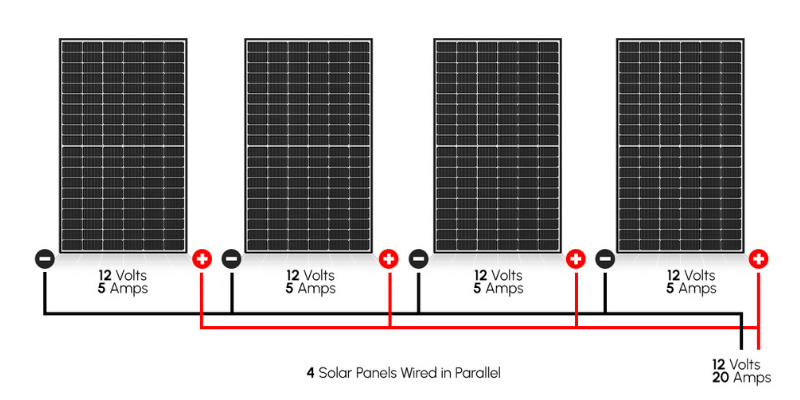
Le graphique ci-dessus montre quatre panneaux de 12 volts et 5 ampères câblés en parallèle. Le courant de sortie est de 20 ampères (5a * 4 = 20a), mais la tension de sortie est toujours de 12 volts.
Ce que c'est mieux pour
Les panneaux solaires en parallèle fonctionnent indépendamment, ce qui les rend idéaux pour les conditions mixtes. Si un ou deux panneaux sont ombrés, les autres généreront toujours de la puissance.
Ils conviennent également aux systèmes à basse tension avec des contrôleurs PWM moins chers, car le câblage en parallèle ne modifie pas la tension de sortie totale. Cette configuration vous permet d'augmenter le courant de charge sans avoir à réguler la tension, à condition que la sortie du panneau correspond à la tension de charge de la batterie.

Panneaux solaires: série ou parallèle, quelle est la meilleure?
Maintenant que nous comprenons les différences entre les panneaux solaires de câblage en série et parallèles, discutons de ce qui est mieux pour votre application.
Les panneaux de câblage en série sont souvent idéaux si vous pouvez les garder principalement non ombrés. Cette configuration améliore l'efficacité, en particulier pendant les conditions de faible luminosité comme les jours tôt le matin ou les jours nuageux.
Une tension plus élevée est nécessaire pour charger les batteries; Par exemple, nos batteries au lithium nécessitent 14,4 volts pour commencer la charge. La plupart des panneaux de 100 watts sortent de 18 à 20 volts, donc les câbler en parallèle nécessite de fonctionner à plus de 75% de capacité.
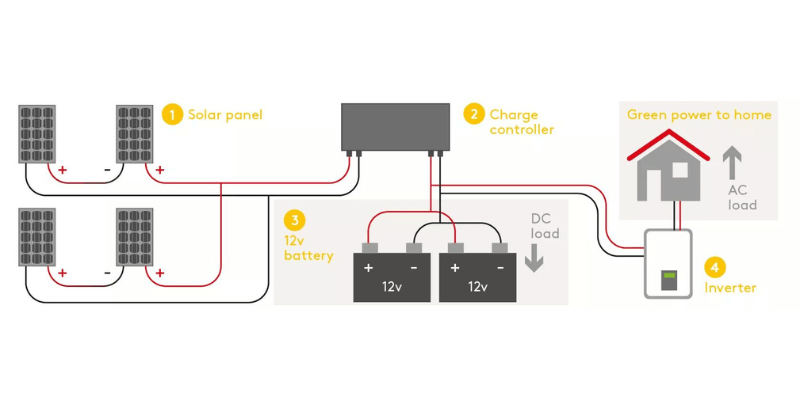
En revanche, la connexion de trois de ces panneaux en série produit 54 à 60 volts, permettant au tableau de fonctionner à seulement 25% de capacité de charge efficace – beaucoup plus facile même tard dans la journée ou les jours nuageux. Notez qu'un contrôleur de charge MPPT est nécessaire pour ce système.
Cependant, le câblage en parallèle n'est pas non plus une mauvaise option. Les contrôleurs MPPT sont chers et peuvent être excessifs pour de petites configurations comme les VR ou les bateaux avec des conditions d'éclairage variables. Dans de tels cas, un système parallèle pourrait bien fonctionner avec un contrôleur de charge PWM à moindre coût, ce qui vous permet d'économiser de l'argent.
Série ou parallèle pour mélanger les types de panneaux
Tu peux Mélanger les panneaux solaires à partir de différents fabricants, mais les conditions diffèrent pour les configurations série et parallèles.
Les panneaux solaires incompatibles en série fonctionnent à l'ampli le plus bas. Dans notre premier exemple, si vous remplacez un panneau par un panneau à quatre ampères, l'ensemble du système sortira quatre ampères.
Dans le câblage parallèle, il augmente les amplis tout en gardant la tension identique.
Conclusion
Il n'y a pas de réponse définitive pour le câblage des panneaux solaires en série ou parallèle, car les deux ont des avantages et des inconvénients. Le câblage en série augmente la tension, tandis que le câblage en parallèle augmente l'ampérage. Le choix dépend de vos besoins et de vos applications spécifiques.
Article connexe :

